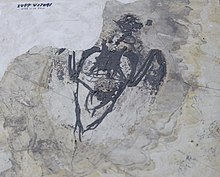| Archaeorhynchus Temporal range: Early Cretaceous,
| |
|---|---|

| |
| Fossil specimen, Paleozoological Museum of China | |
| Scientific classification | |
| Domain: | Eukaryota |
| Kingdom: | Animalia |
| Phylum: | Chordata |
| Clade: | Dinosauria |
| Clade: | Saurischia |
| Clade: | Theropoda |
| Clade: | Avialae |
| Clade: | Ornithothoraces |
| Clade: | Euornithes |
| Genus: | †Archaeorhynchus Zhou & Zhang, 2006 |
| Species: | †A. spathula
|
| Binomial name | |
| †Archaeorhynchus spathula Zhou & Zhang, 2006
| |
Archaeorhynchus (meaning "ancient snout") is a genus of beaked avialan stem-birds from the early Cretaceous period. A fossil of its only known species, Archaeorhynchus spathula, was first reported in 2005 by Zhou & Zhang to have been found in Yixian Formation rocks at Yixian, Liaoning province, China, showing a well-preserved and essentially complete skeleton.[1] Two more complete specimens were found in Lower Cretaceous deposits of Jianchang, Liaoning, northeastern China, preserving new anatomical information. These deposits are 120 million years old, whereas the original specimen was 125 million years old, meaning the age range for this species is 125-120Ma.[2]
Archaeorhychus is one of the earliest avialans known to have had a beak, and represents one of the most basal ornithuromorph avialans.[1] The fossils preserved feathers associated with the neck, head and tail regions. The fossils also show grooves and openings/ holes (foramina) on the tips of the upper and lower jaws, suggesting that it supported a horny bill. Other features present suggest powerful flight capability similar to that of some modern birds.[2] It has also been suggested that it had an herbivorous diet based on preserved gizzard stones found in its stomach.[1]
- ^ a b c Zhou, Z; Zang.F.C. (2006). "A beaked basal ornithurine bird (Aves, Ornithurae) from the Lower Cretaceous of China". Zoologica Scripta. 35 (4): 363–373. doi:10.1111/j.1463-6409.2006.00234.x. S2CID 85222311.
- ^ a b Zhou, S; et al. (2013). "Anatomy of the basal ornithuromorph bird Archaeorhynchus spathula from the early Cretaceous of Liaoning, China". Journal of Vertebrate Paleontology. 33 (33): 141–152. doi:10.1080/02724634.2012.714431. S2CID 86035166.